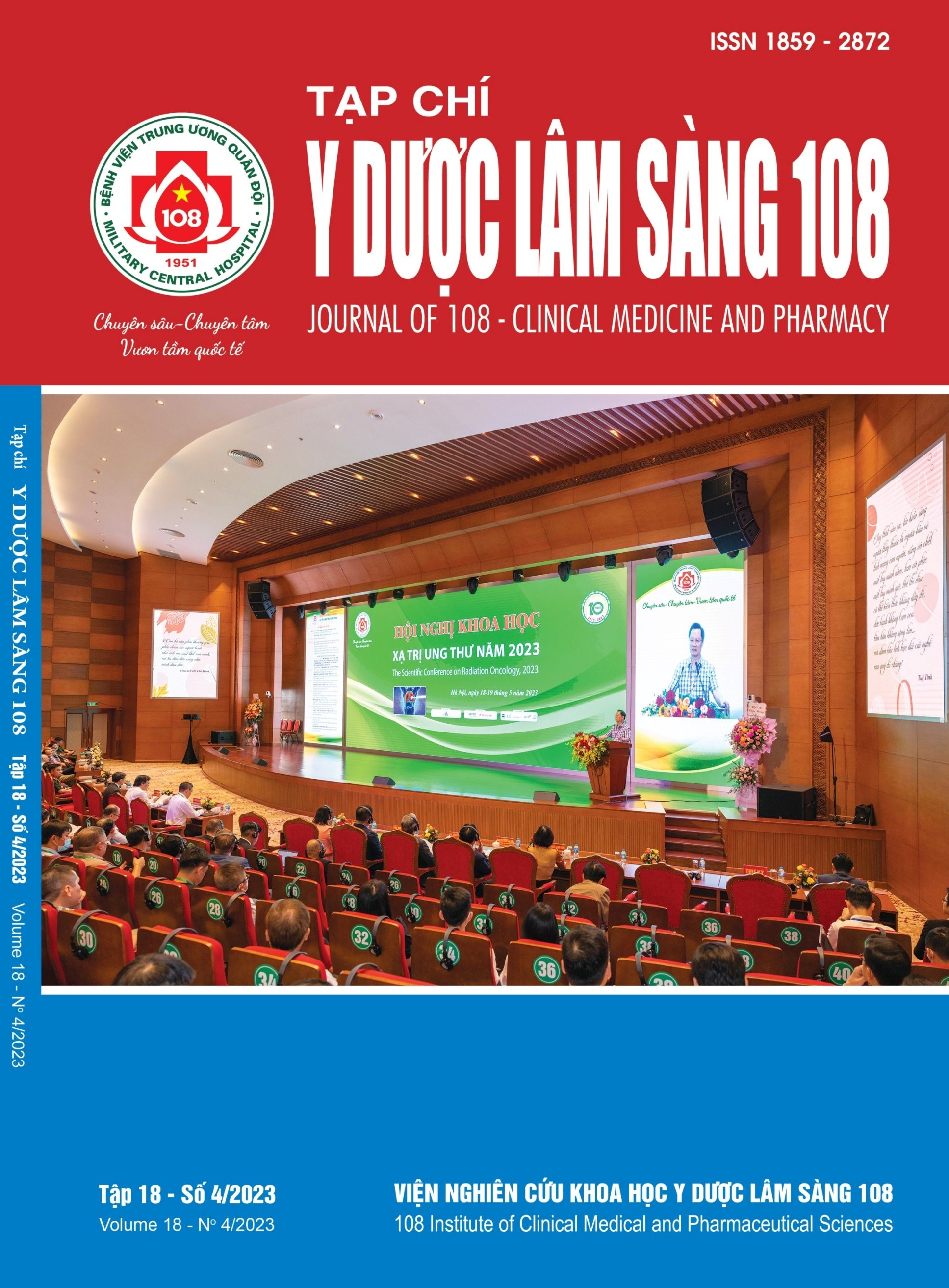Results of percutaneous left main coronary intervention at 108 Military Central Hospital
Main Article Content
Keywords
Abstract
Objective: To evaluate the safety and effectiveness of percutaneous intervention of left main coronary artery at 108 Military Central Hospital. Subject and method: We included 93 patients with confirmed diagnosis of left main coronary artery stenosis and had indications for percutaneous coronary intervention. All anthropometric, clinical and angiographic data were extracted from the Hospital's electronic database system. Major cardiovascular events were recorded through patient history records or telephone interviews. Result: The mean age of the patients was 71.30 ± 8.31 years old, in which male accounted for 79.6%. The most frequent cardiovascular risk factor was hypertension. Clinical presentation: Stable angina (30.6%), unstable angina (19.3%), non-ST-segment elevation MI (26.2%), and acute myocardial infarction with ST elevation (22.2%). The most common lesions were at the bifurcation (62%), patients were mainly intervened through the radial artery (71%), and single stent strategy accounted for 44.1%. During the hospital stay, there were 2 deaths (2.2%), 1 case of stent thrombosis (1%) and after 30 days of follow-up, there were 2 more deaths and 1 case of gastroenterology bleeding. Conclusion: Percutaneous left main intervention is a safe and effective method of treatment with low mortality and stent thrombosis rate.
Article Details
References
2. Chiarito M, Cao D, Nicolas J, Roumeliotis A, Power D, Chandiramani R, Sartori S, Camaj A, Goel R, Claessen BE, Stefanini GG, Mehran R, Dangas G (2021) Radial versus femoral access for coronary interventions: An updated systematic review and meta-analysis of randomized trials. Catheter Cardiovasc Interv 97(7): 1387-1396.
3. Hanson L, Vogrin S, Noaman S, Dinh D, Zheng W, Lefkovits J, Brennan A, Reid C, Stub D, Duffy SJ, Layland J, Freeman M, van Gaal W, Cox N, Chan W; Victorian Cardiac Outcomes Registry Investigators (2022) Long-term outcomes of unprotected left main percutaneous coronary intervention in centers without onsite cardiac surgery. Am J Cardiol 168: 39-46.
4. Levine GN, Bates ER, Blankenship JC, Bailey SR, Bittl JA, Cercek B, Chambers CE, Ellis SG, Guyton RA, Hollenberg SM, Khot UN, Lange RA, Mauri L, Mehran R, Moussa ID, Mukherjee D, Nallamothu BK, Ting HH (2011) 2011 ACCF/AHA/SCAI Guideline for Percutaneous Coronary Intervention. A report of the American College of Cardiology Foundation/American Heart Association Task Force on Practice Guidelines and the Society for Cardiovascular Angiography and Interventions. J Am Coll Cardiol 58(24): 7.
5. Mäkikallio T, Holm NR, Lindsay M et al (2016) Percutaneous coronary angioplasty versus coronary artery bypass grafting in treatment of unprotected left main stenosis (NOBLE): A prospective, randomised, open-label, non-inferiority trial. Lancet 388(10061): 2743-2752.
6. Nguyễn Hoàng Minh Phương, Phạm Thái Giang, Phạm Mạnh Hùng (2021) Khảo sát đặc điểm tổn thương thân chung động mạch vành trái trên siêu âm nội mạch ở bệnh nhân bệnh động mạch vành mạn tính được can thiệp. Tạp chí Y Dược lâm sàng 108. 16(8).
7. Stone GW, Moses JW, and Leon MB (2007) Left main drug-eluting stents: natural progression or a bridge too far? J Am Coll Cardiol 50(6): 498-500. doi: 10.1016/j.jacc.2007.04.055. Epub 2007 Jul 23.
8. Stone GW, Sabik JF, Serruys PW et al (2016) Everolimus-eluting stents or bypass surgery for left main coronary artery disease. N Engl J Med 375(23): 2223-2235.
9. Yap J, Singh GD, Kim JS, Soni K, Chua K, Neo A, Koh CH, Armstrong EJ, Waldo SW, Shunk KA, Low RI, Hong MK, Jang Y, Yeo KK (2018) Outcomes of primary percutaneous coronary intervention in acute myocardial infarction due to unprotected left main thrombosis: The Asia-Pacific Left Main ST-Elevation Registry (ASTER). J Interv Cardiol 31(2): 129-135.
10. Zalewska-Adamiec M, Bachórzewska-Gajewska H, Kralisz P, Nowak K, Hirnle T, Dobrzycki S (2013) Prognosis in patients with left main coronary artery disease managed surgically, percutaneously or medically: A long-term follow-up. Kardiol Pol 71(8): 787-795.
 ISSN: 1859 - 2872
ISSN: 1859 - 2872
